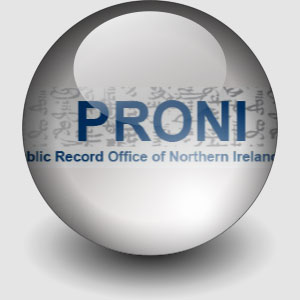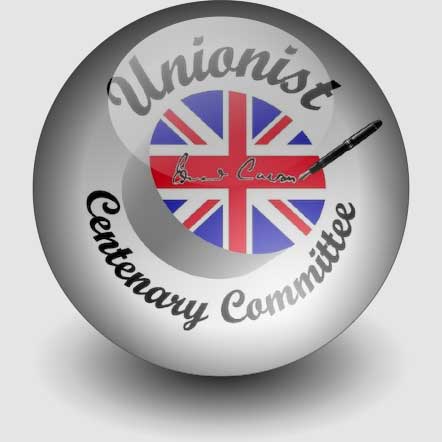Ulster Day
The signing of the Covenant was conducted in an atmosphere of near religious fervour, appearing to many like a crusade, with comparisons being drawn between the Ulster Covenant and the Old Testament Covenant of the Israelites.
Religious services to invoke divine aid and to encourage signatures were held throughout in Protestant churches with the favoured hymn being 'O God, our help in ages past'. Charles Frederick D'Arcy, later Archbishop of Armagh, stated his Church’s reason for supporting the Covenant: "We hold that no power, not even the British Parliament, has the right to deprive us of our heritage of British citizenship".

Factories and the shipyard in Belfast were idle and silent, allowing their workers the opportunity to attend church and then to congregate at the City Hall. The church services ended about noon. Carson and other Unionist leaders left the Ulster Hall and walked the short distance along Bedford Street to the City Hall, preceded by the Boyne Standard and with a guard of men wearing bowler hats and carrying sticks. A body of 2,500 men drawn from Orange lodges and Unionist Clubs marshalled the crowds outside the City Hall throughout the day.

At the City Hall entrance Carson was welcomed by the Lord Mayor and Corporation, the Poor Law Guardians, the Water Board and the Harbour Commissioners. Inside, a circular table draped with the Union Flag was placed in the entrance hall. On it was set the Covenant together with a silver inkstand and Carson’s silver pen. Carson signed first, followed by Lord Londonderry and by representatives of the Protestant Churches, and then by James Craig.

The Unionist Club marshals admitted the general public in batches of four or five hundred at a time until 11pm. Lines of specially made temporary desks set out along the corridors allowed 540 signatures to be taken at a time. Elsewhere there were similar scenes of people enthusiastic to sign. At the Ulster Hall women signed the Declaration. The Duke of Abercorn, in failing health, signed under an oak tree on his estate at Baronscourt. Lord Templetown signed at Castle Upton on an old drum of the Templepatrick Infantry.

Martin Ross (of Somerville &Ross) wrote:
"Four at a time the men stooped and and fixed their signatures and were quickly replaced by the next batch. Down the street in a market house the women were signing, women who had come in flagged motors, and on bicycles and on foot... In the City Hall of Belfast the people were signing at the rate of about a hundred and fifty a minute; here there was no hypnotic force of dense masses, no whirlwind of emotion, only the unadorned and individual action of those who had left their fields and taken their lives and liberties in their hands laying them forth in the open sunshine as the measure of their resolve".
"Four at a time the men stooped and and fixed their signatures and were quickly replaced by the next batch. Down the street in a market house the women were signing, women who had come in flagged motors, and on bicycles and on foot... In the City Hall of Belfast the people were signing at the rate of about a hundred and fifty a minute; here there was no hypnotic force of dense masses, no whirlwind of emotion, only the unadorned and individual action of those who had left their fields and taken their lives and liberties in their hands laying them forth in the open sunshine as the measure of their resolve".

Contrary to popular belief, only one signature is believed to have been in blood, that of Frederick Hugh Crawford, who was to become the Ulster Volunteers’ Director of Ordnance.

In Dublin the Covenant was signed by 2,000 men who could prove that they were born in Ulster. It was also signed in major cities in England and Scotland, and in places further afield including aboard the SS Lake Champlain. From this vessel a letter was received attaching the signatures of 12 second-class passengers, four men and eight women. Among the third-class passengers, 34 had also got the Covenant text, stuck it to a piece of paper and signed.
On the evening of Ulster Day Carson left the Ulster Club in Belfast to travel by wagonette the short distance to the docks, where he boarded the steamer for Liverpool. A journey that should have taken a few minutes took an hour, as around 70,000 people crammed Castle Place beseeching Carson not to leave. As the steamer slowly made its way up Belfast Lough the vast crowd stood singing "Rule Britannia" and "God Save the King". When Carson went ashore at Liverpool next morning a 150,000-strong crowd greeted him with "O God our help in ages past" and conducted him in procession.

The views of non-Unionists on Ulster Day were reflected by the Irish News:
At last the curtain has been rung down on the Ulster Day farce, and we may hope for, at any rate, a temporary return to the civic pride on which Belfast prides itself so tremendously. The Carson circus having toured North East Ulster…gave its final and greatest performance entitled, ‘Signing the Covenant’, in Belfast on Saturday, and wound up its fantastic career in a paroxysm of flag waving and noise, emblematic of the meaningless nonsense of the whole grotesque scheme from start to finish…
At last the curtain has been rung down on the Ulster Day farce, and we may hope for, at any rate, a temporary return to the civic pride on which Belfast prides itself so tremendously. The Carson circus having toured North East Ulster…gave its final and greatest performance entitled, ‘Signing the Covenant’, in Belfast on Saturday, and wound up its fantastic career in a paroxysm of flag waving and noise, emblematic of the meaningless nonsense of the whole grotesque scheme from start to finish…
…..The stage lost an actor manager when the law and politics claimed Sir Edward Carson. His unfailing instinct for theatrical effect was never better exemplified than on the Saturday in his ‘state’ progress from the Ulster Hall to the City Hall. Something was expected from him as the central figure in the ‘historic’ scene and he rose to the occasion splendidly. He evidently aimed at mimicking some great pose from history; he had set himself a part which was a mixture of Cromwell, King William III, with just a suggestion of King Charles I on the way to execution; but he rather spoiled the effect by introducing a swagger reminiscent of Sidney Carton’s farewell. Bareheaded, slightly stooped, and with a well assumed expression of portentousness, he strode between the ranks of his bodyguard - partly Orangemen and Unionist Club members - past batteries of cameras and cinematograph machines, while behind him a standard bearer carried the suspiciously fresh looking orange flag, which is supposed to have waved above the battle smoke of the Boyne. In its present keeping it is not likely to be flourished in anything more exciting than a street riot or a shipyard pogrom….
…….Taking the day’s proceedings altogether they were tame as a demonstration of enthusiasm and highly ludicrous as an indication of the ‘grim and determined’ spirit. The whole grotesque production has been a political failure, though a comic success, and now that it is past and gone, one wonders how many thousands the Ulster Unionists have spent on staging it……








